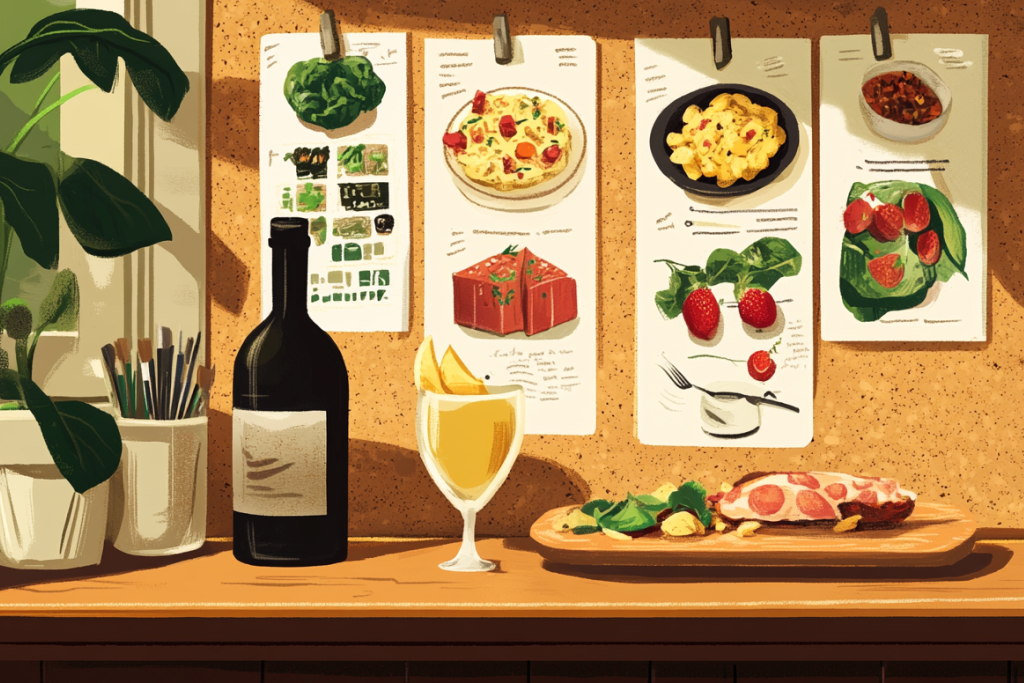Every restaurant owner dreams of maximizing their profits, but few know how to achieve it effectively. Imagine dedicating just one week to refining your menu and witnessing your profits increase by 10% to 15% consistently. That's the power of menu engineering. Learn how to effectively perform menu engineering and give your restaurant menu new life!
What is menu engineering?
Menu engineering is a systematic approach to analyzing the profitability and popularity of menu items, aiming to influence their placement strategically on your menu. The primary goal is straightforward: boost your restaurant's profitability and revenue.
This process isn't just a one-time adjustment; it's about continuous improvement and strategic placement. By understanding which dishes bring the most profit and which are favored by customers, you can create a restaurant menu that not only satisfies taste buds but also maximizes your financial gains. Sometimes, this meticulous strategy culminates in the creation of a menu engineering matrix—a powerful tool that visually represents the financial and emotional appeal of each item on your menu.
Why is menu engineering important?

Restaurant menu engineering isn’t just about tweaking a few dishes; it’s a strategic approach that can dramatically increase your restaurant's profitability while simultaneously enhancing the dining experience for your customers. Here’s why it’s essential:
1. Maximizing profitability
By analyzing each item for cost versus popularity, menu engineering helps you identify which dishes generate the most profit and which might be draining your resources. This information is crucial in deciding what stays, what goes, and what needs a price adjustment.
2. Controlling costs
In today’s economic climate, where inflation and operational costs are at an all-time high, knowing precisely what each menu item costs you and how it performs can be the difference between a struggling or thriving business. Menu engineering enables you to make informed decisions that keep your costs in check without compromising quality.
With 52% of restaurant professionals citing high operating and food costs as their top challenges, having a strategy that directly addresses these issues is more important than ever.
3. Improved customer experience
A well-engineered menu does more than just improve margins—it enhances the overall dining experience. By strategically placing popular and profitable items, you guide customers towards choices that they’ll enjoy and that are economically beneficial for the restaurant.
How to boost your restaurant profits by 10% with menu engineering?
To better explain how to do menu engineering, I will illustrate it with a fictional story about a restaurant owner named Margaret. Through her experience, we will go through each step of profitable menu planning so you can gain a better understanding of how to implement menu engineering in your own business. Let's start!
1. Choose a time frame for analysis
Margaret, who owns a vibrant casual dining restaurant that serves a mix of dishes like pizza, tacos, and nachos, decides to enhance her menu's profitability. With prices ranging from $11 to $31 and options that cater to quick, flavorful meals, she needs to understand when her offerings perform best.
To start the menu engineering process, Margaret picks the summer months for analysis, anticipating it's her busiest season due to the influx of tourists. This period gives her a comprehensive view of what works and what doesn’t, allowing her to find the most profitable menu items and make informed decisions about menu adjustments.
2. Calculate food costs and selling prices
Margaret, eager to ensure her casual dining restaurant remains profitable, undertakes the task of manually calculating the food costs for her diverse menu.
Margaret first lists all ingredients for a basic pizza: dough, sauce, cheese, and toppings. She prices each component based on her latest supplier invoices.
- Dough: $0.50
- Sauce: $0.30
- Cheese: $1.00
- Toppings: $0.70
- Total Ingredient Cost: $2.50
Margaret starts to calculate selling price - she aims for a food cost percentage of 30%.
While many operators simply adopt 30% as standard industry percentage, Margaret opts for a more tailored approach. She estimates her total sales, labor costs, and desired profits for a more accurate calculation. At the end she divides her projected food costs by projected sales, resulting in a food cost percentage that truly reflects her business model and goals.

Using her total ingredient cost, she calculates the ideal selling price:
- Selling price formula: (Ingredient cost / Desired food cost percentage) x 100
- Selling price: ($2.50 / 30%) x 100 = $8.33
3. Perform a menu analysis
Margaret calculates the profitability margin for each item by using the cost percentages and menu prices she previously determined. Her goal is to identify and prioritize items that yield high margins.

- Profit margin: Menu price − Cost per Item
- If a pizza sells for $8.33 and costs $2.50 to make, the profit margin is $5.83.
She then assesses the popularity of each item by comparing its actual sales to its expected popularity. Expected popularity is an estimate of how often items would sell if all menu items were equally popular—a concept also known as the menu mix or sales mix.

- Expected popularity: (Total sales of category/Number of items in category)
- If Margaret's category of main dishes (pizzas, tacos, and nachos) has 300 total sales in a month and includes 3 types of items, the expected popularity for each type is 100 sales.
Then she can determine the actual popularity index.

- Popularity index: (Actual sales/Expected popularity) x 100
- If Margaret sold 120 pizzas, the popularity index is 120% - (120/100) x 100, indicating it is more popular than expected.
By analyzing both profitability and popularity, Margaret can make informed decisions about which dishes to highlight or adjust. Dishes that are both popular and profitable are prime candidates for promotion, while less successful items might be reworked or phased out to optimize the menu’s overall performance.
4. Organize profitable menu items into categories

Once Margaret has analyzed the profitability and popularity of her dishes, she organizes them into a menu matrix. This matrix is a visual tool that helps categorize items based on their performance, making it easier to decide their fate on the menu.
The matrix consists of four quadrants, with popularity increasing along the Y-axis and profitability increasing along the X-axis. This layout allows Margaret to quickly visualize where each menu item stands.
The quadrants are labeled as Stars, Plowhorses, Puzzles, and Dogs, each representing a different combination of popularity and profitability:
- Stars: These items are both highly popular and highly profitable. They are the ideal menu items, delivering both customer satisfaction and strong margins.
- Plowhorses: Popular among customers but less profitable. These items are often well-liked and sell in high volumes, but their lower profit margins make them less ideal.
- Puzzles: Highly profitable but not as popular. These items have good margins but are not as frequently ordered, which may suggest a need for better promotion or perhaps a reevaluation of how they are presented on the menu.
- Dogs: Neither popular nor profitable. These items are candidates for removal as they do not contribute positively to the restaurant's performance.
By applying the menu engineering matrix, Margaret can strategically decide how to promote, adjust, or phase out dishes based on their quadrant placement. This organized approach helps streamline the decision-making process, ensuring that every item on the menu has a clear role in contributing to the restaurant’s overall success.
5. Design (or redesign) restaurant menu according to menu analysis

Following the categorization within the menu matrix, Margaret takes strategic steps to adjust her restaurant menu, optimizing each category for profitability and popularity:
- Stars: Highlighting these items is straightforward. They are both popular and profitable, so they should be prominently featured on the menu. Margaret ensures these items are the first ones seen on the menu and instructs her servers to recommend them enthusiastically.
- Plowhorses: For items like soup-and-salad specials that are popular but less profitable, Margaret explores ways to enhance profitability. She might experiment with a three-salad sampler that maintains customer interest while increasing the dish's margin.
- Puzzles: These are profitable but less popular items. Margaret encourages her staff to actively promote these dishes. She also considers adjusting the pricing or even reinventing some of these items to increase their appeal without sacrificing profitability.
- Dogs: Items in this category do not perform well in terms of popularity or profitability. While it's tempting to remove them completely, some, like the classic grilled cheese sandwich, are essential for certain customer segments, such as children. For these, Margaret opts to de-emphasize them on the menu—simply listing them without promotional efforts or prominent placement.
How to do menu engineering - summary
By meticulously analyzing her menu and making strategic adjustments, Margaret successfully enhanced both the profitability and appeal of her restaurant offerings. If you want to follow her steps, start by gathering data on your current menu performance. Analyze the popularity and profitability of each item, categorize them using the menu matrix, and make informed decisions on how to adjust your offerings. Remember, menu engineering is an ongoing process—regular reviews and adjustments will keep your menu fresh and your profits growing📈
By embracing this strategic approach, you can transform your menu into a powerful tool that contributes significantly to your restaurant's success. Just like Margaret, you have the opportunity to revitalize your menu and see tangible improvements in your profitability!
Menu engineering - FAQ
What are the four types of menu engineering?
The four types of menu items based on menu engineering are:
- Stars: High-profit and high-popularity items,
- Plowhorses: High-popularity but low-profit items,
- Puzzles: High-profit but low-popularity items,
- Dogs: Low-profit and low-popularity items.
What is menu engineering?
Menu engineering is the process of analyzing and optimizing your menu to boost profitability by strategically categorizing and adjusting prices, presentation, and placement of dishes. It involves evaluating the performance of menu items based on their profitability and popularity, leading to informed decisions that improve a restaurant's overall financial performance.
What is the objective of menu engineering?
The main objective of menu engineering is to increase a restaurant's profitability by identifying and promoting high-margin, popular items while minimizing or adjusting low-performing items. It helps optimize the balance between costs, sales, and customer satisfaction to drive better business results.
How to engineer a menu?
First analyze your sales data to understand the performance of each menu item and categorize items into Stars, Plowhorses, Puzzles, and Dogs based on profitability and popularity. Then rework the menu by highlighting Stars, improving or promoting Puzzles, adjusting the pricing or portions of Plowhorses, and considering the removal of Dogs.
What are the advantages of using menu engineering?
Menu engineering offers several advantages: increased profitability by focusing on high-margin items, better decision-making through data-driven insights on item performance, improved customer satisfaction by optimizing popular items and enhancing the overall dining experience and cost control by adjusting or removing less profitable items.
What is menu revenue?
Menu revenue refers to the total income generated from the sales of a restaurant’s menu items. It is influenced by both the pricing and the performance of individual dishes, making menu engineering an essential tool to maximize revenue.
What is a menu mix?
A menu mix is the breakdown of how different items on a menu sell in comparison to each other. It shows the relative popularity of each item and is an essential component in the menu engineering process, as it helps restaurants identify their top sellers and underperformers.

Karol is a serial entrepreneur, e-commerce speaker m.in for the World Bank, and founder of 3 startups, as part of which he has advised several hundred companies. He was also responsible for projects of the largest financial institutions in Europe, with the smallest project being worth over €50 million.
He has two master's degrees, one in Computer Science and the other in Marketing Management, obtained during his studies in Poland and Portugal. He gained experience in Silicon Valley and while running companies in many countries, including Poland, Portugal, the United States, and Great Britain. For over ten years, he has been helping startups, financial institutions, small and medium-sized enterprises to improve their functioning through digitization.



![8 Tips For Graphic Design Portfolio [ + Stunning Examples]](/upload/domain/37991/thumbnails/072__HowToCreateGraphicDesignPortfolio_/Article-Cover-How-To-Create-Graphic-Design-Portfoliox600.webp)

